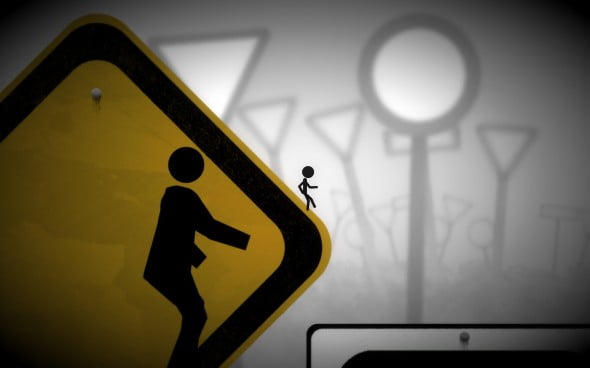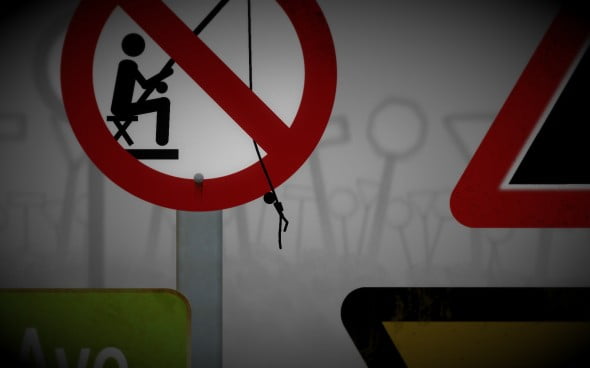Developer: Midnart
Publisher: Midnart
Review Platform: PC (Steam)
Review Copy Provided By: Midnart
Release Date: October 24th, 2014
Sign Motion possesses a seriously unique visual style and core “gimmick”, if you will. You are the young boy from the school crossing sign, and after having escaped said sign and the guardianship of “Sign Mummy/Daddy”, you find yourself running, jumping and swinging through a 2-D world constructed entirely out of various signs. Although this sounds like an interesting concept, the game itself soon squanders its own potential and diverts into a dull bog of shoddy physics, unresponsive controls and unjustifiable heaps of trial and error.
As a puzzle-platformer, Sign Motion is rather reminiscent of LIMBO, although it shares few of that games merits. You guide a small, silhouetted character through a world of crates, ropes and crevices, and the game occasionally slows the pace and demands that you do some lateral puzzle solving. Sign Motion substitutes LIMBO’s dark, haunting world with a world of road, street, safety and hazard signs, some of which are used to create some genuinely neat gameplay quirks. The man on the “No Fishing” sign’s line can be used as a rope, cars from road signs become moving hazards, and airport signs regularly bombard you with silhouetted suitcases. Sign Motion does possess a real spark of creativity, but it only ever scratches the surface of its promising concept, since its platforming sections never exhilarate, and its puzzles never require more than a modicum of problem solving ability .

Where LIMBO’s slow and meandering character movements lent its protagonist an air of vulnerability, Sign Motion‘s sluggish and delayed input-to-action times simply trigger immense frustration. At times, the child will jump right queue, but at others, he/she will only leave the ground after at least a half-second delay (I even had to teach myself to jump a half a step early to compensate). Swinging on ropes is a similarly random affair; taking a long run up for a huge swing can sometimes lead to a pathetic fall, but a tiny, momentum-less jump can just as easily result in near-flight. This is all while assuming that said ropes will behave like real ropes, rather than like flimsy strands of floppy spaghetti as they often do.
Sign Motion‘s unfortunate marriage of wonky physics and lazy controls makes for moment to moment gameplay that’s rarely enjoyable, because it demands that the player be in a near constant failure state. This is made even more frustrating by the game’s cruelly archaic checkpoint system, which places respawn points only after a long series of puzzles and obstacles, all of which vary in difficulty. This means you spend most of your time repeating easy hazards to get to harder ones, a rage inducing affair which renders any initial enjoyment of puzzles and/or platforming sections a distant memory. So distant, in fact, some sections can require thirty or forty attempts at the same tired set of ropes and pits. Trial and error of such ridiculous proportions should only be reserved for games with fast and endlessly addictive gameplay, not long crawls through malfunctioning obstacle courses.

Moreover, there never even feels like enough of a reason to want to endure such hardships. We know that the crossing child has run away from his/her parent, but there’s never any incentive to be reunited with said guardian, particularly when such a reunion means hours of slogging through the same unfair pitfalls. I’m all for understated stories, but giving players absolutely no reason to want to progress in a game is perhaps the worst crime of design one can commit.
To add to this mess, Sign Motion is also home to an ugly bunch of unpredictable, mind boggling bugs and design oversights: the child is often killed by slow collisions with stationary objects, the game offers controller support, but not for its menus, and players are regularly penalized for the slightest misstep when the only solution to a puzzle is sent plummeting down a hole.

In a way, Sign Motion gets undeservedly hoisted by its own petard. Its dedication to filling the world with nothing but signs makes for a treacherous and uneven landscape; since most signs have rounded edges, collision detection often feels spotty, and it can be hard to detect where on a sign the child will actually be able to hang on. The signs have a similarly mixed effect on the game’s visuals too. While bright signs initially appear vivid and striking against their muted, grey backgrounds, they eventually serve only to remind you of the cold, dull neutrality of health and safety seminars. Though it tries to spice things up by including road signs from all around the world, Sign Motion barely escapes the drab mundanity of its chosen subject. There’s a clinical and repressed feel to the world of Sign Motion, a feeling that’s only bolstered by its monotonous soundtrack and the guttural synth sound that accompanies each overly long slow motion death animation.
There’s very little one can praise about Sign Motion, in spite of its genuinely appealing concept. Effectively a gruelling exercise in trial and error set in the mundane world of signage, the game occasionally plays with some interesting ideas, but it rarely elevates them to anything close to memorable or engaging. Sloppy controls and an abundance of random bugs deal the killing blow to a broken and uninspiring game.
Review Overview
Score:
1.5/5
A dull, broken mess of a puzzle platformer, Sign Motion offers a bleak, frustrating, trial and error trudge through dodgy physics puzzles and unpredictable obstacle courses. Its promising concept is not enough to save it from such a woeful list of problems.